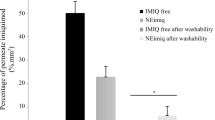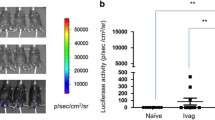Abstract
Primary squamous cell carcinoma of the vagina is an uncommon disease that often exhibits few symptoms before reaching an advanced stage. Topical intravaginal therapies for resolving precancerous and cancerous vaginal lesions have the potential to be non-invasive and safer alternatives to existing treatment options. Two factors limit the testing of this approach: lack of a preclinical intravaginal tumor model and absence of safe and effective topical delivery systems. In this study, we present both an inducible genetic model of vaginal squamous cell carcinoma in mice and a novel topical delivery system. Tumors were generated via activation of oncogenic K-Ras and inactivation of tumor suppressor Pten in LSL-K-Ras G12D/+ Pten loxP/loxP mice. This was accomplished by exposing the vaginal epithelium to a recombinant adenoviral vector expressing Cre recombinase (AdCre). As early as 3 weeks after AdCre exposure exophytic masses protruding from the vagina were observed; these were confirmed to be squamous cell carcinoma by histology. We utilized this model to investigate an anticancer therapy based on poly(lactic-co-glycolic acid) (PLGA) nanoparticles loaded with camptothecin (CPT); our earlier work has shown that PLGA nanoparticles can penetrate the vaginal epithelium and provide sustained CPT release. Particles were lavaged into the vaginal cavity of AdCre-infected mice. None of the mice receiving CPT nanoparticles developed tumors. These results demonstrate a novel topical strategy to resolve precancerous and cancerous lesions in the female reproductive tract.





Similar content being viewed by others
References
Frank S, Jhingran A, Levenback C, Eifel P. Definitive radiation therapy for squamous cell carcinoma of the vagina. International Journal of Radiation Oncology. 2005;62(1):138–47. doi:10.1016/j.ijrobp.2004.09.032.
Sankaranarayanan R, Ferlay J. Worldwide burden of gynaecological cancer: the size of the problem. Best Practice & Research Clinical Obstetrics & Gynaecology. 2006;20(2):207–25. doi:10.1016/j.bpobgyn.2005.10.007.
Cancer Facts and Figures 2010. Atlanta, GA: American Cancer Society2010.
Tjalma W. The role of surgery in invasive squamous carcinoma of the vagina. Gynecol Oncol. 2001;81(3):360–5. doi:10.1006/gyno.2001.6171.
Creasman WT, Phillips JL, Menck HR. The national cancer data base report on cancer of the vagina. Cancer. 1998;83(5):1033–40.
Vaginal Cancer. In: Society AC, editor. Atlanta, GA: American Cancer Society; 2010.
Dixit S, Singhal S, Baboo HA. Squamous cell carcinoma of the vagina: a review of 70 cases. Gynecol Oncol. 1993;48:80–7.
Buck HW, Guth KJ. Treatment of vaginal intraepithelial neoplasia (primarily low grade) with iniquimod 5% cream. Journal of Lower Genital Tract Disease. 2003;7(3):290–3.
Haidopoulos D, Diakomanolis E, Rodolakis A, Vlachos G, Elsheikh A, Michalas S. Safety and efficacy of locally applied imiquimod cream 5% for the treatment of condylomata acuminata of the vulva. Arch Gynecol Obstet. 2003;270(4):240–3. doi:10.1007/s00404-003-0559-9.
Martin-Garcia RF. Imiquimod: an effective alternative for the treatment of invasive cutaneous squamous cell carcinoma. Dermatol Surg. 2005;31:371–4.
Ondo A, Mings S, Pestak R, Shanler S. Topical combination therapy for cutaneous squamous cell carcinoma in situ with 5-fluorouracil cream and imiquimod cream in patients who have failed topical monotherapy. J Am Acad Dermatol. 2006;55(6):1092–4. doi:10.1016/j.jaad.2006.06.031.
Murta EFC, Neves Junior MA, Sempionato LRF, Costa MC, Maluf PJ. Vaginal intraepithelial neoplasia: clinical-therapeutic analysis of 33 cases. Arch Gynecol Obstet. 2005;272(4):261–4. doi:10.1007/s00404-005-0022-1.
Krebs HB, Helmkamp BF. Chronic ulcerations following topical therapy with 5-fluorouracil for vaginal human papillomavirus-associated lesions. Obstet Gynecol. 1991;78(2):205–8.
Venuti A, Massa S, Mett V, Vedova LD, Paolini F, Franconi R, et al. An E7-based therapeutic vaccine protects mice against HPV16 associated cancer. Vaccine. 2009;27(25–26):3395–7. doi:10.1016/j.vaccine.2009.01.068.
Han L, Wang W, Fang Y, Feng Z, Liao S, Li W, et al. Soluble B and T lymphocyte attenuator possesses antitumor effects and facilitates heat shock protein 70 vaccine-triggered antitumor immunity against a murine TC-1 cervical cancer model in vivo. J Immunol. 2009;183(12):7842–50. doi:10.4049/jimmunol.0804379.
Decrausaz L, Gonçalves A-R, Domingos-Pereira S, Pythoud C, Stehle J-C, Schiller J, et al. A novel mucosal orthotopic murine model of human papillomavirus-associated genital cancers. International Journal of Cancer. 2010. doi:10.1002/ijc.25561.
Daikoku T, Hirota Y, Tranguch S, Joshi AR, DeMayo FJ, Lydon JP, et al. Conditional loss of uterine Pten unfailingly and rapidly induces endometrial cancer in mice. Cancer Research. 2008;68(14):5619–27. doi:10.1158/0008-5472.can-08-1274.
Soyal SM, Mukherjee A, Lee KYS, Li J, Li H, DeMayo FJ, et al. Cre-mediated recombination in cell lineages that express the progesterone receptor. Genesis. 2005;41(2):58–66. doi:10.1002/gene.20098.
Dinulescu DM, Ince TA, Quade BJ, Shafer SA, Crowley D, Jacks T. Role of K-ras and Pten in the development of mouse models of endometriosis and endometrioid ovarian cancer. Nature Medicine. 2005;11(1):63–70.
O’Leary J, Muggia FM. Camptothecins: a review of their development and schedules of administration. European Journal of Cancer. 1998;34(10):1500–8.
Wall ME, Wani MC, Cook CE, Palmer KH, McPhail AT, Sim GA. Plant antitumor agents. I. The isolation and structure of camptothecin, a novel alkaloidal leukemia and tumor inhibitor from Camptotheca acuminata. J Am Chem Soc. 1966;88(16):3888–90.
Wall ME, Wani MC. Camptothecin and taxol: from discovery to clinic. J Ethnopharmacol. 1996;51:239–54.
Slichenmyer WJ, Rowinsky EK, Donehower RC, Kaufmann SH. The current status of camptothecin analogues as antitumor agents. Journal of the National Cancer Institute. 1993;85:271–91.
Ertl B, Platzer P, Wirth M, Gabor F. Poly(D, L-lactic-co-glycolic acid) microspheres for sustained delivery and stabilization of camptothecin. Journal of Controlled Release. 1999;61:305–17.
Liu J, Jiang Z, Zhang S, Saltzman WM. Poly(ω-pentadecalactone-co-butylene-co-succinate) nanoparticles as biodegradable carriers for camptothecin delivery. Biomaterials. 2009;30(29):5707–19. doi:10.1016/j.biomaterials.2009.06.061.
Sawyer AJ, Saucier-Sawyer JK, Booth CJ, Liu J, Patel T, Piepmeier JM, et al. Convection-enhanced delivery of camptothecin-loaded polymer nanoparticles for treatment of intracranial tumors. Drug Delivery and Translational Research. 2010;1(1):34–42. doi:10.1007/s13346-010-0001-3.
Woodrow KA, Cu Y, Booth CJ, Saucier-Sawyer JK, Wood MJ, Mark Saltzman W. Intravaginal gene silencing using biodegradable polymer nanoparticles densely loaded with small-interfering RNA. Nat Mater. 2009;8(6):526–33. doi:10.1038/nmat2444.
Jackson EL. Analysis of lung tumor initiation and progression using conditional expression of oncogenic K-ras. Genes & Development. 2001;15(24):3243–8. doi:10.1101/gad.943001.
Lesche R, Groszer M, Gao J, Wang Y, Messing A, Sun H, et al. Cre/loxP-mediated inactivation of the murine Pten tumor suppressor gene. Genesis. 2002;32(2):148–9. doi:10.1002/gene.10036.
Tuveson DA, Shaw AT, Willis NA, Silver DP, Jackson EL, Chang S, et al. Endogenous oncogenic K-rasG12D stimulates proliferation and widespread neoplastic and developmental defects. Cancer Cell. 2004;5:375–87.
Davis BJ, Dixon D, Herbet RA. Pathology of the Mouse. Vienna: Cache River Press; 1999.
Leslie NR, Downes CP. PTEN function: how normal cells control it and tumour cells lose it. Biochem J. 2004;382:1–11.
Elmasry K, Gayther S. Genetic mutations in gynaecological cancers. Reviews in Gynaecological and Perinatal Practice. 2006;6(3–4):115–25. doi:10.1016/j.rigapp.2006.05.009.
Kim TH, Wang J, Lee KY, Franco HL, Broaddus RR, Lydon JP, et al. The synergistic effect of conditional Pten loss and oncogenic K-ras mutation on endometrial cancer development occurs via decreased progesterone receptor action. Journal of Oncology. 2010;2010:1–10. doi:10.1155/2010/139087.
Hill R, Calvopina JH, Kim C, Wang Y, Dawson DW, Donahue TR, et al. PTEN loss accelerates KrasG12D-induced pancreatic cancer development. Cancer Research. 2010;70(18):7114–24. doi:10.1158/0008-5472.can-10-1649.
Najbauer J, Yang Y, Iwanaga K, Raso MG, Wislez M, Hanna AE, et al. Phosphatidylinositol 3-kinase mediates bronchioalveolar stem cell expansion in mouse models of oncogenic K-ras-induced lung cancer. PLoS ONE. 2008;3(5):e2220. doi:10.1371/journal.pone.0002220.
Iwanaga K, Yang Y, Raso MG, Ma L, Hanna AE, Thilaganathan N, et al. Pten inactivation accelerates oncogenic K-ras-initiated tumorigenesis in a mouse model of lung cancer. Cancer Research. 2008;68(4):1119–27. doi:10.1158/0008-5472.can-07-3117.
Hildesheim A, Han CL, Brinton LA, Nasca PC, Richart RM, Jones RB, et al. Sexually transmitted agents and risk of carcinoma of the vagina. International Journal of Gynocologic Cancer. 1997;7:251–5.
Fuste V, del Pino M, Perez A, Garcia A, Torne A, Pahisa J, et al. Primary squamous cell carcinoma of the vagina: human papillomavirus detection, p16INK4A overexpression and clinicopathological correlations. Histopathology. 2010;57(6):907–16. doi:10.1111/j.1365-2559.2010.03727.x.
Hellman K, Alaiya AA, Schedvins K, Steinberg W, Hellström AC, Auer G. Protein expression patterns in primary carcinoma of the vagina. British Journal of Cancer. 2004. doi:10.1038/sj.bjc.6601944.
Hellman K, Silfversward C, Nilsson B, Hellstrom AC, Frankendal B, Pattersson F. Primary carcinoma of the vagina: factors influencing the age at diagnosis. The Radiumhemmet series 1956—96. International Journal of Gynocologic Cancer. 2004;14:491–501.
Four year efficacy of prophylactic human papillomavirus quadrivalent vaccine against low grade cervical, vulvar, and vaginal intraepithelial neoplasia and anogenital warts: randomised controlled trial. BMJ. 2010;340:c3493. doi:10.1136/bmj.c3493.
Patton TJ, Kavanagh JJ, Delclos L, Wallace S, Haynie TP, Wharton T, et al. Five-year survival in patients given intra-arterial chemotherapy prior to radiotherapy for advanced squamous carcinoma of the cervix and vagina. Gynecol Oncol. 1991;42:54–9.
Cone RA. Barrier properties of mucus. Advanced Drug Delivery Reviews. 2009;61(2):75–85. doi:10.1016/j.addr.2008.09.008.
Lai SK, Wang YY, Hida K, Cone R, Hanes J. Nanoparticles reveal that human cervicovaginal mucus is riddled with pores larger than viruses. Proceedings of the National Academy of Sciences. 2009;107(2):598–603. doi:10.1073/pnas.0911748107.
Cu Y, Saltzman WM. Mathematical modeling of molecular diffusion through mucus. Advanced Drug Delivery Reviews. 2009;61(2):101–14. doi:10.1016/j.addr.2008.09.006.
Cu Y, Saltzman WM. Controlled surface modification with poly(ethylene)glycol enhances diffusion of plga nanoparticles in human cervical mucus. Mol Pharm. 2008;6(1):173–81.
Saltzman WM. Drug delivery: engineering principles for drug therapy. New York: Oxford University Press; 2001.
Acknowledgments
The authors thank Gordon Terwilliger (Yale University, New Haven, CT) for his technical assistance in retrieving and preparing tissue samples and Dr. Daniela Dinulescu (Boston, MA) for supplying primer sequences for recombination analysis. J.S.B was supported through a National Institutes of Health postdoctoral fellowship (F32 AI072942) and I.A.B. was supported through a Gilliam Fellowship from Howard Hughes Medical Institute. This work was supported by grants to W.M.S. from the National Institutes of Health (R01 EB000487) and to F.J.S. from the James S. McDonnell Foundation.
Ethical standards
All experiments performed in this manuscript are in compliance with the current laws of the State of Connecticut and the United States of America.
Author information
Authors and Affiliations
Corresponding author
Rights and permissions
About this article
Cite this article
Blum, J.S., Weller, C.E., Booth, C.J. et al. Prevention of K-Ras- and Pten-mediated intravaginal tumors by treatment with camptothecin-loaded PLGA nanoparticles. Drug Deliv. and Transl. Res. 1, 383–394 (2011). https://doi.org/10.1007/s13346-011-0038-y
Published:
Issue Date:
DOI: https://doi.org/10.1007/s13346-011-0038-y




